Tag: photography
Julia Donner & Taneli Eskola: Löytöretki Helsinkiin. Exploring Helsinki. Helsingfors på upptäcktsfärd
20 August 2009 | Mini reviews, Reviews
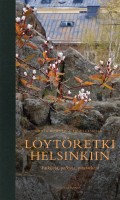 Löytöretki Helsinkiin. Paikkoja, polkuja, puutarhoja. Exploring Helsinki. Places, paths, gardens. I Helsingfors på upptäcktsfärd. Platser, stigar, trädgårdar
Löytöretki Helsinkiin. Paikkoja, polkuja, puutarhoja. Exploring Helsinki. Places, paths, gardens. I Helsingfors på upptäcktsfärd. Platser, stigar, trädgårdar
Helsinki: Multikustannus, 2008. 167 p., ill.
ISBN 978-952-468-147-6
€ 42, hardback
In this book, author Julia Donner and photographer Taneli Eskola make a walking tour of the less familiar byways of their native Helsinki, in the changing seasons between 2007 and 2008. Donner quotes authors and poets while recording some of the city’s history. She takes the reader through places often ignored – small, modest enclosures between buildings that only just qualify for the name of parks, suburban parklands or the rocky spaces that have been left untouched in the heart of the city. Eskola’s photographs record the graphic details of frost and sleet as well as the first tinges of spring green, of flora, rocks, water and sky. Some of the text is printed in both Swedish and English. A map would have been useful to readers who are not familiar with Helsinki; some of the photographs also lack captions. This beautiful book, designed by Timo Numminen, is an original series of views that have not been prettified but are true to the everyday life of the city. And readers who live in Helsinki will be surprised by what they discover.
Worlds apart
18 June 2009 | Extracts, Non-fiction
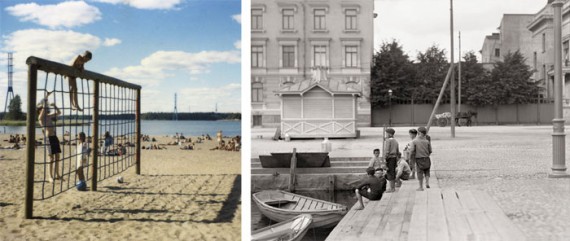
Helsinki boys by the sea: in Martti Jämsä’s Polaroid lads play on the beach; in I.K. Inha’s photograph (Hietalahden satama, ‘Hietalahti harbour’), taken a century earlier, barefoot urchins meet up on the quayside
A hundred years ago the photographer I.K. Inha (1865–1930) was asked to illustrate a tourist guide to Helsinki. He took some 200 photographs, of which some 60 were included in the book, which was published by WSOY in 1910. In his new book of photographs, OPS! Helsinki Polaroid¹, Martti Jämsä (born 1959), wanders the same streets a century on, taking snapshots with his Polaroid camera. More…
Sealspotting
14 June 2009 | Reviews
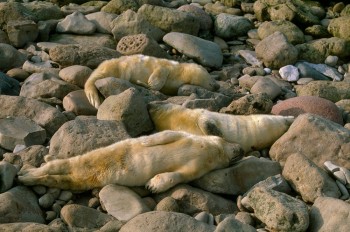
Zzzzzzz! In the grey seal kindergarten babies take a nap after dinner. – Photo: Seppo Keränen
Taskinen, Juha
Paluu Saimaalle
[Return to Lake Saimaa]
Helsinki: WSOY, 2009. 204 p., ill.
ISBN 978-951-0-33745-5
€ 38.90, hardback
Keränen, Seppo & Lappalainen, Markku
Hylkeet [The seals]
Helsinki: Maahenki, 2009. 151 p., ill.
ISBN 978-952-56-5266-6
€ 45, hardback
Sälar
Helsingfors: Söderströms, 2009.
151 p., ill.
Swedish translation: Annika Luther
ISBN 978-951-52-2603-7
€ 45, hardback
The private life of the species of seal that lives only in Lake Saimaa has been carefully investigated lately. Almost everything about this highly endangered species has been revealed, thanks to technological devices such as transmitters that can be glued to their backs…
STOP! WARNING: as I realise that not everybody wants to know what pinnipeds do in their spare time, I suggest you quit reading now, if you aren’t interested in the lives and fates of an obscure group of about 260 mammals that live in a lake in the remote west of Finland.
Netta Böök & Juhani Seppovaara: Kirkosta savusaunaan [From churches to smoke saunas]
4 June 2009 | Mini reviews, Reviews
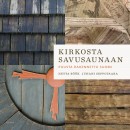 Kirkosta savusaunaan. Puusta rakennettu Suomi
Kirkosta savusaunaan. Puusta rakennettu Suomi
[From churches to smoke saunas. A Finland built of wood]
Helsinki: Otava, 2008. 175 p., ill.
ISBN 978-951-1-20337-7
€ 33, hardback
Photographer Juhani Seppovaara and architectural journalist Netta Böök have collected examples of timber construction: timber was traditionally used to build churches, cottages, villas, farmhouses, parsonages, saunas, manor houses and entire residential neighbourhoods. The authors even include dance pavilions – thousands of them were built around the country after the Second World War. As early as the end of the 18th century, doctors were recommending timber houses as healthy places to live in. However, wars and fires have destroyed many of Finland’s wooden buildings. The book also presents stories of those who lived in them and built them. The 1960s and 1970s in particular saw the demolition of valuable timber-constructed neighbourhoods, which were pulled down in order to make way for structures of a more modern kind. Today timber is once more an inspiration for builders and developers.
Self-made man
1 April 2009 | Extracts, Non-fiction
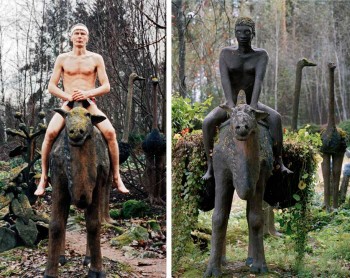
On camelback: in the exotic part of Veijo Rönkkönen’s concrete cosmos there are animals and palm trees, side by side with the living plants of the northerly latitudes. - Photo, left: Veijo Rönkkönen; right: Veli Granö.
Extracts and photographs from Veijo Rönkkösen todellinen elämä / The real life of Veijo Rönkkönen (Maahenki, 2007. Translation: Kirsti Nurmela-Knox)
